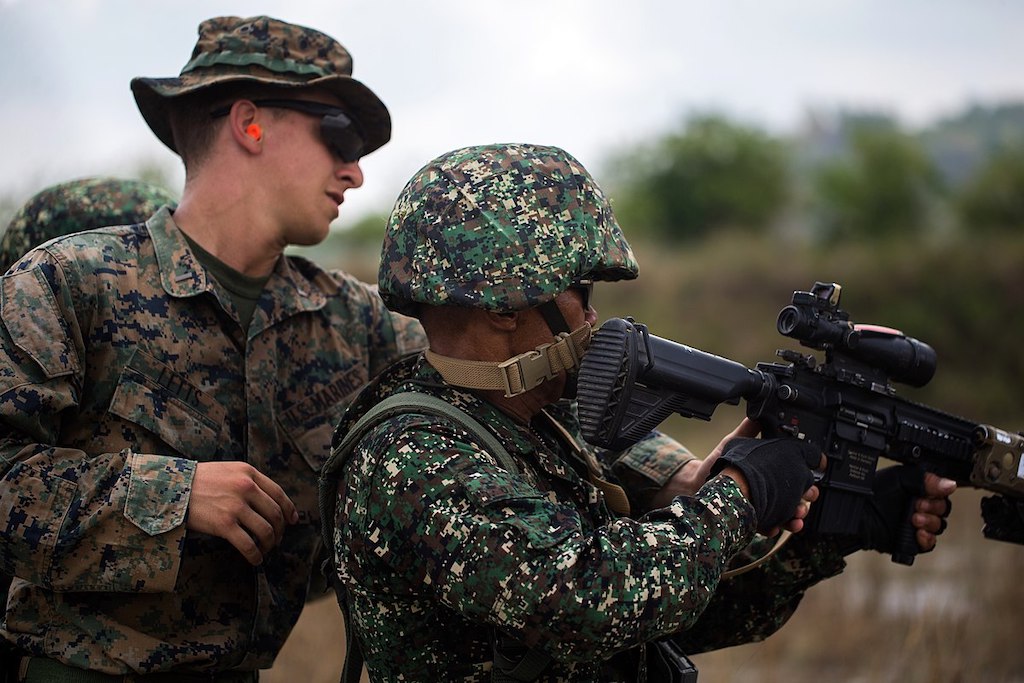Water Wars: South China Sea Situation Normal, All Fouled Up
Despite a diplomatic row between China and the Philippines, U.S. and Philippine military officials denied that their recent military exercise was a response to Chinese threats.

Published by The Lawfare Institute
in Cooperation With

Despite a diplomatic row between China and the Philippines, U.S. and Philippine military officials denied that their recent military exercise was a response to Chinese threats. Philippine presidential spokesman Salvador Panelo insisted on April 15 that U.S.-Philippine naval drills were part of the long-scheduled Balikatan 2019 exercise and not due to “the so-called present conflict between China and the Philippines.” Balikatan is an annual U.S.-Philippine exercise that concluded its 35th iteration on April 12. This year’s exercise included a scenario in which U.S. and Philippine forces repelled a foreign power that had captured a Philippine island. It also coincided with increased tensions around the contested island of Thitu (Tagalog: Pag-asa; Chinese: Zhongye).
Since January, around 275 Chinese maritime militia boats have gathered near Philippine-controlled Thitu in the Spratly Islands (Tagalog: Kapuluan ng Kalayaan; Chinese: Nansha). Philippine President Rodrigo Duterte told Beijing on April 4 to “lay off” Thitu or else face “suicide missions” by his soldiers. With Philippine midterm elections approaching in May, several hundred Filipinos protested China’s actions on April 9 in Makati City, east of Manila. Protestors also criticized the Philippine government for not responding to Chinese activities that were “almost an invasion” of the country’s territory in the West Philippine Sea—the Filipino name for the South China Sea.
In response to the Thitu tensions, former Philippine Foreign Affairs Secretary Albert del Rosario urged the Duterte administration to “unshelve” and implement the 2016 Permanent Court of Arbitration ruling that invalidated much of China’s maritime claims in the South China Sea. President Duterte’s spokesman denied accusations that the Duterte administration had ever “shelved” the 2016 arbitral ruling. He said that it only remains unenforceable because “no foreign force seems persuaded to help us enforce it.” He added that del Rosario himself was responsible for the loss of Scarborough Shoal (Tagalog: Panatag; Chinese: Huangyan) to China in 2012. These comments appear to be the first time a senior Philippine official admitted that Manila is no longer in control of Scarborough Shoal.
Meanwhile, Philippine Foreign Affairs Secretary Teodoro Locsin said on April 16 that the Philippines will take legal action against China over mass harvesting of giant clams in Scarborough Shoal. Philippine media had reported that the Chinese Coast Guard have been driving away Philippine fisherman from the shoal. Manila has filed diplomatic protests, with the presidential spokesman saying the Philippines is ready to do something “more aggressive” if negotiations with China fail. Yet, President Duterte reiterated on April 17 that armed conflict with China would be devastating for the Philippines.
Chinese Foreign Ministry Spokesperson Lu Kang responded to Philippine assertions by stating that there is “sufficient historical and legal basis” for China’s territorial claims over the Spratly Islands, which includes Thitu.
President Duterte landed in Beijing on April 24 for a forum on China’s Belt and Road Initiative. Speaking to the press in Beijing, the Philippine ambassador to China stated that the Philippines has called for “mutual self-restraint” in the South China Sea to avoid a conflict.
Other foreign warships also appear to be in the vicinity of the Spratlys. The amphibious assault ship USS Wasp may still be in the South China Sea after Balikatan 2019, while Russian destroyers recently visited Manila. Russian media reported that the Russian ships were scheduled to head back out into the South China Sea on April 13, with joint Russia-China naval drills scheduled at the end of April and early May.
In Other News…
Elsewhere Around the South China Sea
The U.S. Coast Guard (USCG) has joined the U.S. Navy in the Asia-Pacific, increasing U.S. presence in the region. The USCG cutter Bertholf pulled into Hong Kong on April 15, with the Seventh Fleet flagship USS Blue Ridge arriving in Hong Kong on April 20. The Bertholf recently participated in international efforts in the East China Sea to prevent illicit ship-to-ship transfers of fuel and coal that skirt U.N. sanctions against North Korea. The Bertholf’s Hong Kong port visit was also the first time a Coast Guard vessel has visited the Chinese territory in 17 years. The Coast Guard’s increasing role in the Asia-Pacific comes as the U.S. Navy continues to respond to Chinese activities with two fewer Japan-based destroyers due to 2017 collisions. One of those destroyers—the USS Fitzgerald—left its dry dock on April 16, following two years of repairs from a collision that killed seven sailors.
Vietnam has been slowly adding buildings and self-defense fortifications on 10 of its islets in the South China Sea. While China’s island reconstruction receives significant coverage from international media, Vietnam’s islet improvements have been incremental. Vietnam also avoids using large construction ships that might garner international attention.
In the Western Pacific
Taiwan’s military spokesman announced on April 15 that the military budget would increase from $11.34 billion to over $13 billion by 2027. Although a paltry sum compared to Beijing’s $177.5-billion military budget in 2018, the increase serves mainly to counter the growing military threat from mainland China, according to the spokesman.
On the same day of this announcement, Taiwanese military aircraft and ships shadowed five Chinese warplanes flying south of Taiwan en route to the Western Pacific for military drills. The fly-by occurred two weeks after two People’s Liberation Army Air Force (PLAAF) Jian-11 fighter jets crossed the Taiwan Strait median on March 31. Taiwan’s Ministry of Foreign Affairs had called the median crossing an “intentional, reckless & provocative action.” The incident was the first time Chinese jets had crossed the median since 2011, making it the first such incursion under Chinese President Xi Jinping’s administration.
To the north, an official at Japan’s National Institute of Defence Studies said that Japan scrambled its fighters 999 times in the last financial year to intercept foreign aircraft—nearly two-thirds of which were Chinese military planes. The intercept figure is the second highest on record for Japan, only behind the 2015-2016 financial year, in which Japanese fighters intercepted planes 1,168 times. A majority of both years’ intercepts were in response to Chinese military plane incursions close to Okinawa and nearby Senkaku Islands (Chinese: Diaoyu) in the East China Sea. Japan’s National Institute of Defence Studies believes China is testing Japanese air-defense and fighter response times.
From India to China
From April 2 to April 14, several warships from the Indian and Australian navies participated in AUSINDEX-19, a maritime exercise in the Bay of Bengal. Submarines, helicopters and long-range reconnaissance aircraft from both navies also participated.
China commemorated the People’s Liberation Army Navy’s (PLAN) 70th anniversary on April 23 with a naval parade in the eastern Chinese port of Qingdao. President Xi Jinping kicked off the parade, stating in his speech, “The Chinese people love and long for peace.” The parade featured 32 Chinese ships and 39 aircraft, along with vessels from 13 foreign countries. PLAN Vice Admiral Qiu Yanpeng said that the PLAN Liaoning aircraft carrier, new nuclear submarines and new destroyers were to make their “public debut.” A naval symposium in Qingdao continued through April 25 with delegations from 61 countries.
Analysis
South China Morning Post writer Richard Heydarian calls the events surrounding Thitu a “Scarborough Shoal-like crisis” that could derail President Duterte’s attempts to build a strong relationship with China. Reuters’s Peter Apps draws similar conclusions, noting that U.S. and Russian warships are also sailing in the vicinity of the Spratlys. The stage appears set for another tense fishing season in the South China Sea.
In the Diplomat, Steven Stashwick writes that the U.S. Army’s major Pacific exercise in 2020 will focus on China-based scenarios in the South and East China Seas. The 2020 Defender Pacific exercise will deploy a U.S. Army division to operate in the Philippines and Thailand, while also coordinating with forces from Malaysia, Indonesia and Brunei. Stashwick thinks the geography and multinational component of the exercise is part of a U.S. Army shift to new domains, such as assisting the U.S. Navy in targeting enemy ships and exercising sea control in the South China Sea.
Retired PLAN Captain Liu Xiaobo—not to be confused with the deceased Chinese Nobel Peace Prize laureate Liu Xiaobo jailed for subversion—writes about how China can resolve deadlock around freedom of navigation operations (FONOPs) in the South China Sea. Liu blames U.S. FONOPs for turning the South China sea into “a political battlefield with a legal façade.” He argues that if China makes only verbal protests against continued U.S. FONOPs, the United States will win by undermining China’s “maritime rights” and national credibility. But China responding to FONOPs with military force would also unlikely stop the FONOP program. Liu cited Soviet rammings and their failure to stop U.S. warships from exercising innocent passage in the Black Sea during the Cold War. Liu recommends that, rather than focus on territorial disputes, Beijing should negotiate with Washington on the U.S. FONOP program. He argues the United States might consider rolling back its FONOP activities if China amends its domestic law and policies on innocent passage and military activities in China’s exclusive economic zone. Such a policy shift could also meet China’s long-term interest in exercising freedom of navigation far from Chinese shores, as Chinese projects like those under the Belt and Road Initiative continue to grow.
There is finally a smart U.S. response to the Belt and Road Initiative, argues Erin Dunne in the Washington Examiner. To help countries avoid debt-traps from Chinese loans, teams of U.S. lawyers, economists and diplomats have been helping scrutinize international contracts for lopsided conditions and outright bad deals. A U.S. team helped improve the Myanmar government’s multibillion-dollar deal with China for a deep-water port. Dunne says that rather than compete directly with China in infrastructure financing, the United States should continue to help other governments negotiate deals that will actually benefit their respective countries.





